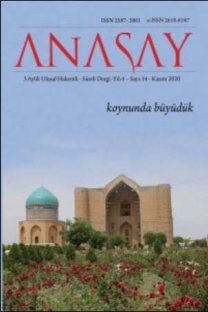BİLGİ TOPLUMU SÜRECİNDE ŞİİRİN DÖNÜŞÜMÜ
Bilgi toplumu, Bilgi, Şiir, Dijital şiir, Edebiyat, Dijital edebiyat, İnternet, İnternet şiiri, İnternet edebiyatı, Information society, Information, Poetry, Digital poetry, Literature, Digital literature, Internet, Internet poetry, Internet literature
Types Of Women In The Historical Romans Of Necîb Mahfûz
Najib Mahfuz, ‘Abesu'l-Akdâr, Radûbîs, Kifâh Tîbe, Types of Women,
___
- ARIKAN, Arda (2008), “Using Internet Groups in the Learning of Literature”, Hacettepe Üniversitesi Eğitim Fakültesi Dergisi, 34, (19-26). CALVI, Licia-BUCHANAN, Paul (2010), A Case on Generative Art: Digital Poetry, Edinburgh: Create10. DRESANG, Eliza T.-MCCLELLAND, Kathryn (1999), “Radical Change: Digital Age Literature and Learning”, Theory Into Practice, 38 (3), [160]-167. ELYAKOV, A. D. (2010), “The Nature of the Modern Information Society”, Scientific and Technical Information Processing, 37 (1), 60-73. FLEMING-MAY, Rachel A.-GREEN, Harriett (2016), “Digital Innovations in Poetry: Practices of Creative Writing Faculty in Online Literary Publishing”, Journal of the Association for Information Science and Technology, 67 (4), 859-873. FRED, Ana-vd (Ed.) (2016), Communications in Computer and Information Science: Vol. 631. Automatic Generation of Poetry Inspired by Twitter Trends, (13-27) içinde. Cham, İsviçre: Springer. HAMIDI, Foad-BALJKO, Melanie (2010), GROUP '10: Proceedings of the 16th ACM International Conference on Supporting Group Work. Collaborative Poetry on the Facebook Social Network, (305-306) içinde. New York: ACM Digital Library. HARTLOVA, Eliska (2013), Mobtwit Mobile Social Poetry with Tweets, University of Amsterdam Faculty of Science Bachelor Thesis, Amsterdam. HEYLIGHEN, Francis-LENARTOWICZ, Marta (2017), “The Global Brain as a model of the future information society: An introduction to the special issue”, Technological Forecasting & Social Change, 114, 1-6. HOCKX, Michel (2015), Global Chinese Culture: Internet Literature in China, New York: Columbia University Press. HUGHES, Janette (2007), “Poetry: A Powerful Medium for Literacy and Technology Development”, What Works? Research into Practice, 10, [1-4]. INWOOD, Heather (2015), “Poetry for the People?: Modern Chinese Poetry in the Age of the Internet”, Chinese Literature Today, 5 (1), 44-54. KAC, Eduardo (Ed.) (2007), Media Poetry: An International Anthology, Bristol: Intellect Books. MARTINEZ, Alfredo Blanco (2016), INTED Proceedings. Instagram as a Social Media Tool to Learn Spanish Poetry: An Experience with Students of a Level, (6292-6297) içinde. Valencia, İspanya: IATED. MICUNOVIC, Milijana-MARCETIC, Hana-KRTALIC, Maja (2016), “Literature and Writers in the Digital Age: A SmallScale Survey of Contemporary Croatian Writers’ Organization and Preservation Practices”, PDT&C, 45 (1), 2-16. RICHEY, Deborah-KRATZERT, Mona (2005), “‘I Too Dislike It’: The Evolving Presence of Poetry on the Internet”, Journal of Library Administration, 43 (3-4), 41-54. SAKSIDA, Marino (1997), “The Information Society in the 21st Century: Converting from Analogue to Digital”, Intl. Inform. & Libr. Rev., 29, 261-267. SHIRKEY, Cynthia D. (2003), “E-poetry: Digital Frontiers for an Evolving Art Form”, College and Research Libraries News, 64 (4), 249-251. ŞENGÜL, Servet (2019), “Dijitalleşen Edebiyat ve ‘Elestirihaber.com’ Örneği”, Atatürk Üniversitesi Edebiyat Fakültesi Dergisi, 63 (12), 289-303. TONTA, Yaşar (2009), “Dijital Yerliler, Sosyal Ağlar ve Kütüphanelerin Geleceği”, Türk Kütüphaneciliği, 23 (4), 742-768. WILLIAMS, Nerys (2011), Contemporary Poetry, Edinburgh: Edinburgh University Press. WILSON, Mark I.-KELLERMAN, Aharon-COREY, Kenneth E. (2013), Global Information Society: Technology, Knowledge, and Mobility, Lanham: Rowman & Littlefield Publishers. WYCKOFF, Andy (2012), “Information society: Which way now?”, Organisation for Economic Cooperation and Development. The OECD Observer, 293, 18.
- ISSN: 2587-2001
- Yayın Aralığı: Yılda 4 Sayı
- Başlangıç: 2017
- Yayıncı: İshak KÜÇÜKYILDIZ
TÜRK SİNEMASINDA AİLE KURUMUNUN TEMSİLİ VE DÖNÜŞÜMÜ
MYANMAR (BURMA) MÜSLÜMANLARININ TARİHİ
DEMOKRAT PARTİ DÖNEMİ 19 MAYIS KUTLAMALARININ AYIN TARİHİ MECMUASI’NA YANSIMASI (1950-1955)
ADANA ULU CAMİ MİHRABI ÜZERİNE BİR DEĞERLENDİRME
TURİZMDE BÜTÜNLEŞTİRMENİN SALİHLİ (MANİSA) ÖZELİNDE DEĞERLENDİRİLMESİ
OYUNLAŞTIRMANIN PAZARLAMADAKİ GÜCÜ
Erman AKILLIBAŞ, Kutalmış Emre CEYLAN
